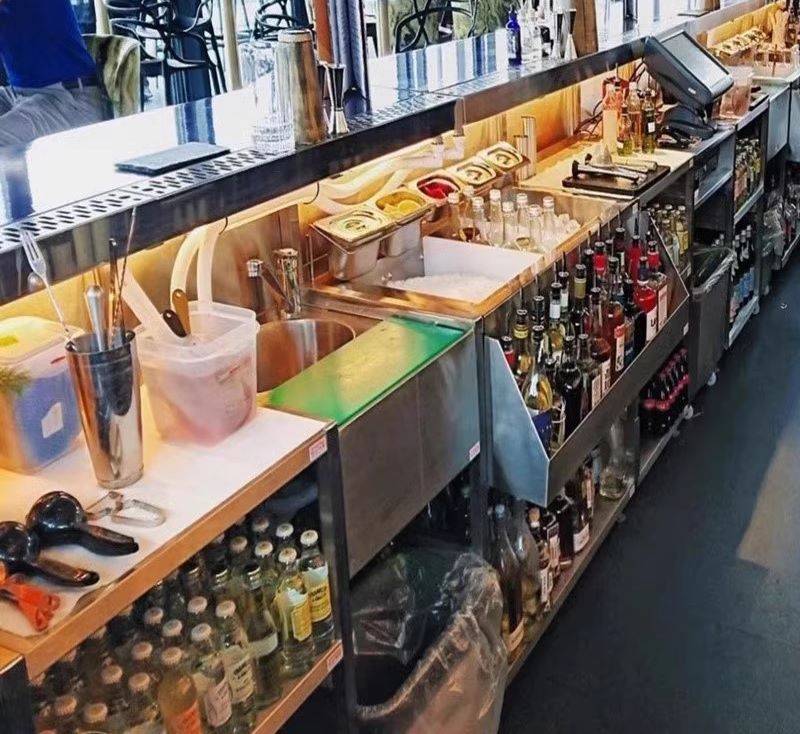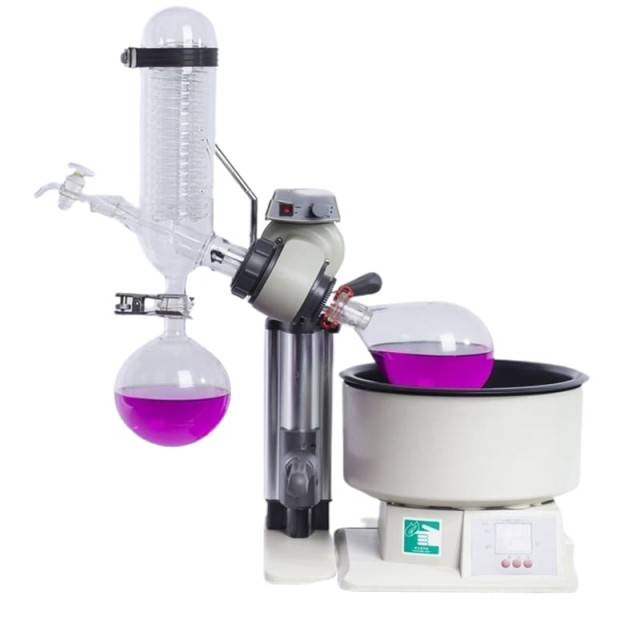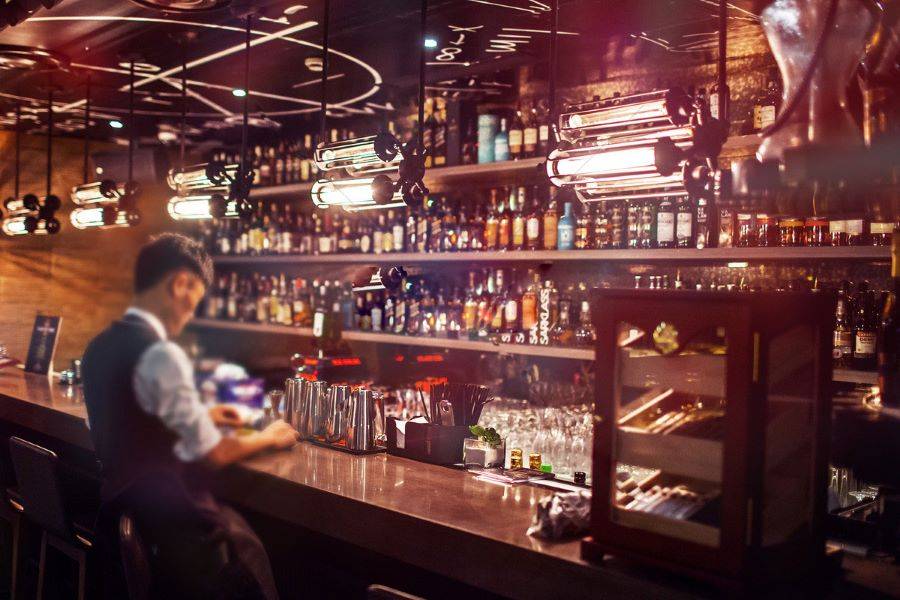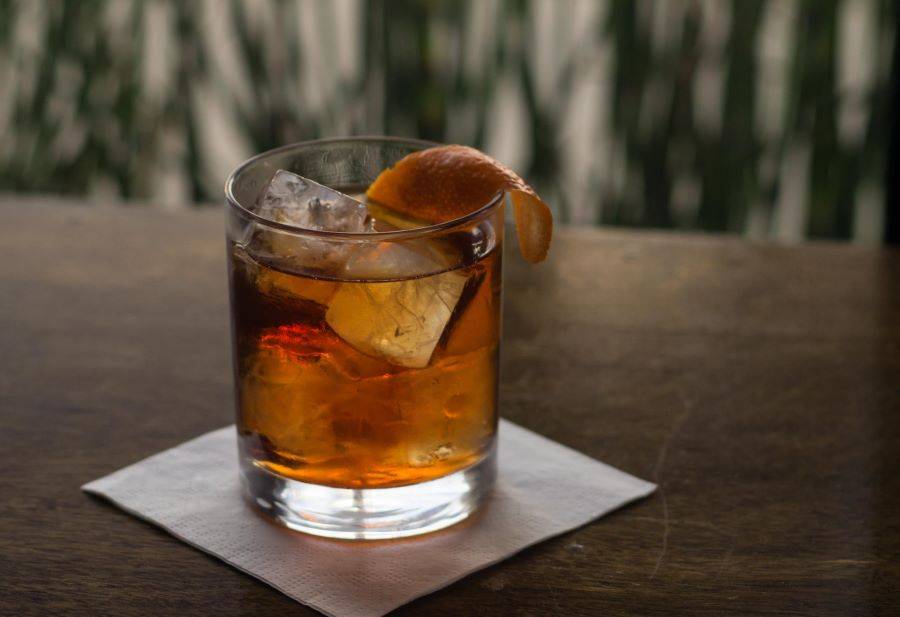Evolution of Cocktail Bars
Traditional Bar Displays
From the 1800s to the early 21st century, cocktail bars were characterized by the grand display of bottles at the back, a practice that symbolized their style and sophistication. These displays were not just for show; they were integral to the bartending process. Bartenders would meticulously arrange these bottles, often filled with a variety of spirits, liqueurs, and infusions, to create a visual narrative of their craft.
The bottles were more than mere containers; they were tools of the trade. Bartenders would use these bottles in conjunction with syrups, juices, and other ingredients to concoct a wide array of cocktails. The arrangement of these bottles was a form of artistry, with each bottle placed with precision to facilitate quick and efficient access during service. This practice was a testament to the skill and knowledge of the bartender, as they navigated through the complexities of flavor combinations and cocktail recipes.
Moreover, these displays served as a form of communication between the bartender and the patron. The variety and arrangement of the bottles could tell a story about the bar's offerings, its history, and its approach to mixology. It was a visual cue that invited patrons to explore the diverse range of flavors and experiences that the bar had to offer.
In essence, the traditional bar display was a cornerstone of the cocktail bar experience, reflecting the symbiotic relationship between aesthetics and functionality in the world of mixology.

Shift Towards Minimalism
Over the past decade, the landscape of cocktail preparation has undergone a significant transformation, moving away from the ornate and elaborate displays that once dominated the back bars of traditional establishments. This shift towards minimalism is not merely a stylistic choice but a response to the increasing complexity of cocktail creation. As bartenders delve deeper into the science of mixology, the tools and techniques they employ have evolved, leading to a more streamlined and focused presentation at the bar.
The rise of rotary evaporators, or Rotovaps, has played a pivotal role in this transition. These devices, which lower the boiling point of liquids through vacuum distillation, allow for the gentle extraction of flavors while minimizing oxidation. This precision in flavor preservation has necessitated a rethinking of how bars present their ingredients. Instead of cluttered shelves filled with various bottles and syrups, modern cocktail bars now often feature a more minimalist setup, with a few key pieces of equipment—like rotary evaporators—taking center stage.
This minimalist approach not only reflects the technical advancements in cocktail preparation but also aligns with the growing emphasis on transparency and craftsmanship in the industry. Bartenders are increasingly keen on showcasing the distillation process itself, often positioning rotary evaporators where guests can see them in action. This visibility underscores the skill and artistry involved in creating each drink, turning the back bar into a stage for mixological performance rather than a mere storage area.
In essence, the shift towards minimalism at the back of the bar is a testament to the evolving nature of cocktail culture. It signifies a move from the ostentatious to the essential, where the focus is on the quality and purity of ingredients, the precision of techniques, and the artistry of the bartender. This new paradigm not only enhances the guest experience but also elevates the craft of cocktail making to a level of sophistication that was previously unimaginable.
Role of Rotary Evaporators
Introduction and Popularity
Rotary evaporators, commonly known as Rotovaps, have revolutionized the landscape of high-concept cocktail bars worldwide. Originating in the vibrant cocktail scene of London, these devices have quickly gained traction and are now indispensable tools in bars across the globe. The adoption of rotary evaporators marks a significant shift in cocktail preparation, moving away from traditional methods towards more sophisticated and nuanced techniques.
In London, the birthplace of this trend, innovative bartenders began to experiment with rotary evaporators, leveraging their ability to distill liquids at lower temperatures. This innovation not only preserved the delicate flavors of spirits and ingredients but also opened up new avenues for cocktail creation. As word spread and the benefits of using these devices became apparent, the popularity of rotary evaporators surged, leading to their widespread adoption in cocktail bars around the world.
Today, rotary evaporators are not just tools for distillation; they are symbols of a bar's commitment to quality and innovation. From the bustling streets of Barcelona to the serene alleys of Paris, these devices have become central to the cocktail-making process, allowing bartenders to push the boundaries of flavor and creativity. The global spread of rotary evaporators underscores the ever-evolving nature of the cocktail industry, where tradition and innovation coexist in a dynamic balance.

Operational Principle
Rotary evaporators, commonly referred to as Rotovaps, operate on a principle that is both sophisticated and efficient. These devices lower the boiling point of liquids through a process known as vacuum distillation. This method is particularly advantageous in the context of cocktail creation, as it allows for a gentle distillation process that preserves the delicate flavors and aromatic compounds of the ingredients.
Vacuum distillation works by reducing the pressure around the liquid, which in turn lowers its boiling point. This is crucial because it prevents the high temperatures typically associated with traditional distillation methods, which can cause the evaporation of volatile flavor compounds. By maintaining a lower temperature, rotary evaporators ensure that the final product retains its nuanced flavors and aromas.
Additionally, this gentle distillation process minimizes oxidation, a common issue in traditional distillation that can lead to the degradation of flavor profiles. Oxidation occurs when oxygen interacts with the liquid, causing it to lose its freshness and complexity. Rotary evaporators effectively mitigate this risk, resulting in a distilled product that is not only pure but also vibrant and true to its original essence.
In essence, the operational principle of rotary evaporators lies in their ability to create a controlled environment that optimizes the distillation process. This not only enhances the quality of the final product but also allows bartenders to explore new dimensions of flavor and creativity in their cocktail creations.
Case Studies
London's Crossroads Bar
At London's Crossroads Bar, the integration of innovative technology into the traditional bar setting is both a spectacle and a tool for crafting unique cocktails. Positioned prominently at the back of the bar, the Girovap serves as a focal point, allowing patrons to witness the intricate distillation process in real-time. This transparent display not only educates guests about the advanced techniques employed but also adds a layer of theater to the cocktail-making experience.
The Girovap, a specialized rotary evaporator, plays a crucial role in the creation of high-concept cocktails. By lowering the boiling point of liquids through vacuum distillation, it ensures that the delicate flavors and aromas of the ingredients are preserved, minimizing oxidation and enhancing the overall taste profile. This method allows bartenders to extract complex flavors from a variety of ingredients, from botanical herbs to exotic fruits, resulting in cocktails that are both innovative and deeply nuanced.
Moreover, the visibility of the Girovap fosters a deeper connection between the bartenders and their audience. Guests can observe the meticulous process of distillation, from the initial infusion to the final condensation, gaining a newfound appreciation for the craftsmanship involved in each drink. This interactive element transforms the bar into a dynamic space where science meets art, and where every cocktail tells a story of precision and creativity.
Sips Bar in Barcelona
At Sips Bar in Barcelona, the focal point of the bar's innovative cocktail creation process is the rotary evaporator, prominently displayed for all guests to see. This transparent approach not only showcases the bar's commitment to cutting-edge techniques but also invites patrons to witness the intricate distillation process firsthand. The rotary evaporator, positioned at the back of the bar, serves as a testament to the bar's dedication to pushing the boundaries of traditional cocktail-making.
The visibility of the rotary evaporator from the bar's seating area underscores the importance of this technology in modern cocktail creation. It allows guests to appreciate the science behind their drinks, from the gentle distillation that preserves the delicate flavors to the vacuum distillation that lowers the boiling point, ensuring a smoother, more refined taste. This open display fosters a deeper connection between the bartenders and their audience, as patrons can observe the meticulous care and precision that goes into each cocktail.
Moreover, the rotary evaporator at Sips Bar is not just a piece of equipment; it is a symbol of the bar's ethos. By making the distillation process visible, Sips Bar aligns itself with the global trend of high-concept cocktail bars that prioritize transparency and innovation. This approach not only enhances the guest experience but also positions Sips Bar as a leader in the evolving landscape of cocktail culture, where technology and tradition blend seamlessly to create unforgettable drinks.
Himkok Bar in Oslo
At Himkok Bar in Oslo, Paul Aguilar has elevated the art of cocktail creation to new heights by employing a rotary evaporator. This innovative tool allows Aguilar to distill ingredients with precision, resulting in avant-garde cocktails that push the boundaries of traditional mixology. One of his standout creations is the Beetroot Martini, which features a clear beet distillate that retains the earthy essence of beets while eliminating the usual color and texture.
The rotary evaporator's ability to lower the boiling point of liquids through vacuum distillation ensures that the flavors are preserved and the oxidation process is minimized. This methodical approach enables Aguilar to extract the purest essence from each ingredient, transforming them into clear, flavorful distillates that form the foundation of his unique cocktails. The Beetroot Martini is a testament to this technique, offering a crisp, clean taste that belies its complex preparation.
Aguilar's use of the rotary evaporator at Himkok Bar exemplifies the growing trend of high-concept cocktail bars embracing advanced technology to enhance their craft. By integrating this sophisticated equipment into his repertoire, Aguilar not only sets Himkok apart but also contributes to the broader evolution of cocktail bars, where innovation and tradition coexist harmoniously.

Little Red Door in Paris
At Little Red Door in Paris, Alex Francis has embraced the rotary evaporator as a cornerstone of his innovative cocktail creations. One of his signature drinks, aptly named 'No Chili Spice,' exemplifies the aromatic finesse that can be achieved through this technique. Unlike traditional methods that might overwhelm with capsaicin heat, Francis leverages the rotary evaporator to gently distill chili peppers, preserving their nuanced flavors without the fiery kick.
This approach not only showcases the versatility of the rotary evaporator but also highlights the meticulous attention to detail required in modern cocktail making. By stripping away the capsaicin, Francis allows patrons to fully appreciate the complex bouquet of chili peppers, from the subtle sweetness of bell peppers to the earthy undertones of poblanos. The result is a drink that tantalizes the senses, offering a harmonious balance of flavors that is both refreshing and sophisticated.
In essence, the rotary evaporator at Little Red Door serves as more than just a piece of equipment; it is a tool that enables Francis to push the boundaries of traditional cocktail making, offering a new dimension to the art of mixology.
Non-Alcoholic Cocktails
Kitchen Table in London
At Kitchen Table in London, rotary evaporators are not just a tool for creating alcoholic beverages; they are integral to crafting sophisticated non-alcoholic cocktails that elevate food pairing experiences. The bar has mastered the art of using these devices to distill delicate flavors, such as Oyster Leaf Distillate, which adds a unique marine essence to dishes without the alcoholic content. This technique allows for a nuanced interplay between food and drink, where the flavors of the cocktail complement the culinary offerings without overpowering them.
The use of rotary evaporators in this context is particularly innovative, as it extends the boundaries of what non-alcoholic cocktails can achieve. By lowering the boiling point of liquids through vacuum distillation, these devices ensure that the flavors are preserved and refined, minimizing oxidation and maintaining the integrity of the ingredients. This method not only enhances the taste profile but also allows for the creation of complex, layered drinks that were previously thought to be exclusive to their alcoholic counterparts.
In essence, Kitchen Table's approach to non-alcoholic cocktails demonstrates how advanced technology can be harnessed to create beverages that are not only delicious but also intricately paired with food, offering a holistic dining experience that appeals to a broad spectrum of patrons, including those who abstain from alcohol.
Wild Child in Shawnee, Kansas
At Wild Child in Shawnee, Kansas, the innovative use of a rotary evaporator has revolutionized the creation of non-alcoholic spirits. This cutting-edge device, known for its precision in vacuum distillation, allows for the gentle extraction of flavors, preserving the essence of each ingredient without the need for alcohol. One of the standout creations is a non-alcoholic version of the classic Negroni, a drink traditionally known for its bold, bittersweet profile. By employing the rotary evaporator, Wild Child is able to distill and concentrate the flavors of Campari, vermouth, and bitters, resulting in a sophisticated drink that retains the complexity and depth of the original, sans alcohol. This technique not only caters to the growing demand for non-alcoholic options but also elevates the craft of cocktail-making, demonstrating how modern technology can enhance the art of mixology.
Challenges and Expertise
Operational Expertise
Operating a rotary evaporator demands a specialized skill set, akin to mastering a complex musical instrument. Bartenders must not only understand the operational principles of vacuum distillation but also how to manipulate the device to achieve the desired flavor profiles. This expertise is crucial for the successful creation of innovative cocktails, as it ensures that the delicate flavors are preserved without the detrimental effects of oxidation.
To operate a rotary evaporator effectively, bartenders must be proficient in setting the appropriate vacuum pressure and temperature. These parameters directly influence the boiling point of the liquid, which in turn affects the extraction and concentration of flavors. For instance, a slight variation in temperature can transform a mild herbal note into a robust, aromatic essence, or conversely, reduce it to a faint whisper.
Moreover, the use of rotary evaporators requires a deep understanding of the chemical interactions between different ingredients. Bartenders must anticipate how these interactions will evolve during the distillation process, much like a chef who knows how ingredients will meld in a dish. This knowledge allows them to craft cocktails that are not only visually appealing but also harmonize in taste, creating a seamless and immersive drinking experience.
In essence, the operational expertise required to use rotary evaporators is a blend of scientific precision and creative intuition. It is this combination that elevates cocktail creation from a mere craft to an art form, where each drink tells a unique story through its meticulously distilled flavors.

Role in Creativity
While the equipment itself does not generate new ideas, rotary evaporators serve as a powerful tool that enables bartenders to translate their creative concepts into tangible, high-quality cocktails. These devices offer a level of precision and control that traditional methods cannot match, allowing for the delicate extraction and preservation of flavors that would otherwise be lost.
For instance, the rotary evaporator's ability to lower the boiling point of liquids through vacuum distillation ensures that the volatile aromatic compounds in ingredients are not compromised. This means that bartenders can create complex, nuanced drinks that highlight the subtleties of their ingredients, rather than masking them with strong flavors or excessive alcohol.
Moreover, the visual appeal of rotary evaporators—often prominently displayed in cocktail bars—adds an element of theater to the cocktail-making process. Guests can watch as their drinks are meticulously crafted, turning the experience into a sensory journey that goes beyond just taste. This interactive aspect not only enhances the customer experience but also serves as a testament to the bartender's skill and creativity.
In essence, rotary evaporators act as an extension of the bartender's imagination, providing the means to execute innovative ideas with finesse and flair.

